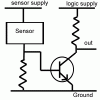I would like to use a particular hall effect sensor based flow meter for monitoring irrigation flow rates. The manufacturer will only tell me how to use it with their controller, but seems ok with me using it for other purposes. Problem is, I've got to create an interface circuit to enable a micro-controller to "count the pulses", but the supplier naturally won't share their hall effect sensor schematic. So, I'm trying to figure out how to design a circuit that will transform what appears to be a current sync type output into logic level pulses.
Here's what I have so far:
With 15V applied across the 2 sensor leads, the current draw is about 2.7 mA when the sensor is not active, and 12+ mA when active. 15V seems to be the 'sweet spot' as there is highest current differential between active and non-active.
(Note that active current varies with supply voltage between 10mA @ 12.9v and 14.5mA @ 19.2v, while the current stays about 2.7mA in the non-active state across the same range)
Here's what I have so far:
With 15V applied across the 2 sensor leads, the current draw is about 2.7 mA when the sensor is not active, and 12+ mA when active. 15V seems to be the 'sweet spot' as there is highest current differential between active and non-active.
(Note that active current varies with supply voltage between 10mA @ 12.9v and 14.5mA @ 19.2v, while the current stays about 2.7mA in the non-active state across the same range)


